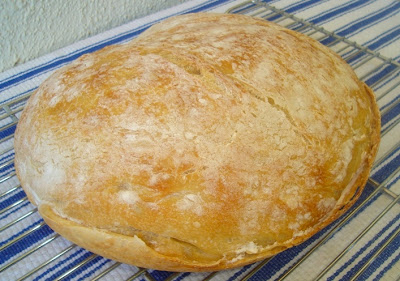I have a confession that may put my baking prowess in question: Bread Scares Me. Not in the carb-phobic L.A. kind of way (Sister, please! I blog about baking!), but in a "I-am-just-so-very-frightened-that-I'll-never-
get-it-to-turn-out-right" kind of way. All the kneading, the rising, the importance of gluten--it's all just been too much. Up until this point, I was so happy to leave the art of bread making to the pros and purchase crusty artisanal loaves from my favorite boulangeries. And then my latest kitchen purchase came along:

After barely justifying the hefty (literally and financially) purchase to myself and the husband, I had no other choice but to work my new Le Creuset 5 1/2 quart dutch oven. And going off of the sales pitch from my friendly Williams-Sonoma clerk ("You can roast in it, braise in it! Soups! Stews! It slices, it dices!") I decided to research what kinds of recipes I could bake in my new buddy. A simple Google search later, and I was met with roughly one bazillion websites and blogs discussing a phenomenon known as No Knead Bread, which, as legend would have it, gets the best results when baked in a Le Creuset dutch oven. Hooray!
"Wait, what do you mean Southern California has been in the grip of a treacherous heat wave? I'm baking BREAD, everyone!" I cried.
Nothing was going to hold me back. Not even the fact that I am nearly a year late on the No Knead trend. I've been called many lovely things in my lifetime--avant-garde is not one of them.
The pioneer in this case is Jim Leahy, owner of Sullivan Street Bakery in New York City. He developed this recipe and has lost a bit of the credit for it, because it was a New York Times article by Mark Bittman that really threw the recipe into the mainstream. Bittman, I salute you, you are a fine writer. But Jim Leahy, you sir deserve the Noble Prize for Carb Support for coming up with this one, and helping even yeast-skeered little old me make a loaf of gorgeous crusty bread that I believe made my husband forget the $200 Williams-Sonoma charge on the credit card. Well done, Mr. Leahy.
Since this recipe has been all the rage with foodies for quite some time, I was able to do a lot of research before beginning my No Knead adventure. Given the insanely warm weather, how temperamental this recipe can be and and what I already know about measuring ingredients in baking, I decided to seek out a recipe that gave measurements in weight (grams) not volume (cups). A cup of flour can contain up to 20 grams more or less than you think it does, depending on humidity, how you measure it, and how it was stored. Measuring by weight seemed to be the most foolproof method.
I was also careful to seek out photos of what the dough should look like when properly risen after the first rise (doubled in volume and covered in bubbles, indicating prime yeast action) and how long that should take (a broad window of 12-24 hours, depending on who you listen to). As I mentioned before, we were having quite the heat wave here in Southern California, even at the beach, so "room temperature" in my non-air-conditioned apartment was about 80 degrees, more than the recommended room temperature of 70 degrees. For this attempt, I decided to let the first rise go 16 hours, since the recipe I followed suggested 12-18 hours and it would be rising in a slightly warmer space. I also decided to forgo what would surely be a messy second rise in a kitchen towel in exchange for a lightly greased bowl, with no ill effect on the final result.

As for the ingredients, I used King Arthur Bread Flour, to which my current baking Bible, Baking Illustrated, gave rave reviews. I used Brita-filtered water, my favorite fleur de sel, and Fleischmann's Rapid Rise Yeast in the foil packets. and then later saw some No Kneaders warning against using this kind of yeast, and that it's better to use the kind for bread machines that comes in a jar. Well, my first loaf of this bread made with foil-packet instant yeast rose well and had a phenomenal crust, so next time I will try the kind in the jar which I'm assuming will take this bread to some new level none of us can comprehend. Probably.
This loaf of bread was, in short, almost really good. The texture is what was most impressive here: a crackly, thick, substantial crust, an interior littered with delightful holes, and a crumb that is chubby and chewy and simply divine.

So we have a great foundation here. But as for its flavor, ehhhh...well, given its beautiful appearance and the way shards of crisp crust spat about the kitchen upon slicing, I was longing for a more sourdough flavor, and just didn't get it this time. The husband was impressed though. At any rate, it was perfectly lovely with our dinner that night when it accompanied foods with big, bold flavors: a buttery brie, a sharp aged cheddar and a dippably juicy and garlicky tomato, white bean and basil salad over mixed greens.

I am going to play with this recipe a bit more and report back. I am very confident that a few adjustments will really make this bread live up to its grand reputation. Stay tuned...



0 komentar:
Post a Comment